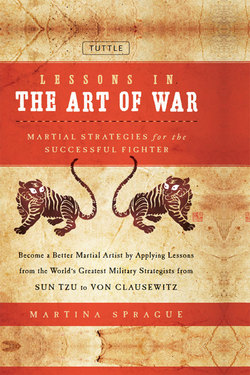Lessons in the Art of War

Реклама. ООО «ЛитРес», ИНН: 7719571260.
Оглавление
Martina Sprague. Lessons in the Art of War
CONTENTS
AN INTRODUCTION. TO ASIAN AND WESTERN. MILITARY THOUGHT
CHAPTER 1. THE NATURE AND CONDUCT. OF COMBAT
CHAPTER 2. WHAT IS COMBAT?
CHAPTER 3. PREPARING FOR BATTLE
CHAPTER 4. ELEMENTS OF TACTICS. AND STRATEGY
CHAPTER 5. IMPOSING YOUR WILL
CHAPTER 6. DESTROYING THE. ENEMY FORCE
CHAPTER 7. STRENGTH OF THE. DEFENSIVE POSITION
CHAPTER 8. FAILURE
CHAPTER 9. MORAL QUALITY. OF COURAGE
CHAPTER 10. SECURING VICTORY
CONCLUSION
NOTES
BIBLIOGRAPHY
Отрывок из книги
“Warfare is the greatest affair of state, the basis of life and death, the Way to survival or extinction.”
— Sun Tzu
.....
Despite the influences of different cultural beliefs, Asia and the West experienced similar problems with respect to the security of the state and external and internal unrest. Both viewed combat as “a true political instrument” and the highest expression of a person’s will to live, “the basis of life and death, the Way to survival or extinction.”27 The differences between Sun Tzu and Clausewitz may at first seem profound. Yet on a conceptual level, their discourse displays far more similarities than differences which further demonstrates that factors such as time period (Sun Tzu and Clause-witz were separated in time by more than two millennia), geographical location (Asia versus Europe), and cultural issues (debated by military historian Victor Davis Hanson in his book, Carnage and Culture) are less significant in combat than are an understanding and embrace of a universal human nature. Whether Asian or Western in origin, the different styles of martial arts employ techniques similar in concept and execution. Once individual fighters have corrected for the geographical area (or the modern sports arena) and the “political” situation (or the mores under which one studies the art), they will face similar difficulties with respect to power, deception, confusion, physical conditioning, and morale.
The author acknowledges that the military histories of Asia and Europe are long and complex and that this book merely scratches the surface. However, by engaging in critical study of the respective regions, one can eliminate inappropriate methods of analysis and reach a greater appreciation for the complexity of events that have led us to this day. Rather than emphasizing spiritual paths, “ways of living,” or self-cultivation, this book differs from other philosophical or historical martial arts studies by presenting the military theories behind the development of tactics and strategy in the combat arts. Theory gives structure to fact, relates the past to the present through logical links, and strengthens and refines judgment. Many of the distinct fighting styles that exist have been practiced since antiquity. Others are hybrids or modern inventions. It is not possible to cover all fighting styles or even a majority in a book this size; however, the author hopes that the martial arts surveyed will at least provide a fair sampling of what is available for study to the interested scholar.
.....